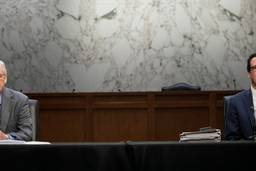Biden, Don't Worry About "Overheating" the Economy
Common metrics that deficit hawks often point to as evidence of economic overheating are not convincing.
Josh Bivens

This article was first published by the “Working Economics Blog” of the Economic Policy Institute.
Recent proposals for large-scale fiscal relief and recovery from the economic effects of COVID-19 have drawn criticism that they could lead to “overheating” of the U.S. economy. These criticisms should be ignored. Proposals under discussion — including Biden’s economic plan introduced on January 14—are highly unlikely to lead to any durable uptick in inflation or interest rates (the normal indicators of “overheating”). And even if they did, these higher interest rates and inflation would be a welcome sign of economic healing, not something to worry about.
Warnings about economic “overheating” normally mean that growth in spending by households, businesses and governments (known as aggregate demand) will outpace growth in the economy’s productive capacity — the stock of potential workers and capital that can be used to produce goods and services to satisfy aggregate demand. When demand growth outpaces growth in the economy’s productive capacity, the result can be upward pressure on inflation (too much demand chasing too few goods and services which drives up prices). In normal times, the Federal Reserve is the nation’s inflation guard dog, and if upward pressure on inflation threatened to move it durably above what the Federal Reserve has announced as its inflation target (2%), the Fed will raise interest rates to slow growth in aggregate demand. The overheating concern is often directed at any deficit-financed fiscal plan, as the Biden relief and recovery plan appropriately is.
But profound changes in the U.S. and global economies over the past generation have made it much harder to “overheat” the economy and, in fact, have made a too-cold economy the bigger problem. Most notably, the huge rise in inequality has redistributed income to wealthier households much more likely to save it rather than spend it. All else equal, this has slowed aggregate demand growth and made it less necessary for the Fed to raise interest rates to fight off inflation driven by overheating (sometimes this chronic demand shortfall is called “secular stagnation,” sometimes it is referenced as the “falling neutral rate of interest,” but the upshot is clearly that demand-growth is running too-cold). Some quick numbers to make the point: Between 1979 and 2000, the main interest rate controlled by the Fed averaged over 7%. Since 2000 it has averaged 1.7%, and since 2007 less than 1%. Overheating has become a far less pressing problem for the U.S. economy, even if too many economic observers and policymakers haven’t fully realized it.
The 2019 labor market — the last year before the Covid-19 shock — also illustrates how hard it is to overheat the modern U.S. economy. The unemployment rate averaged 3.7% that year, the lowest level since 1969. Normally, this unemployment rate would be low enough to make economists worry that empowered workers would demand wage increases in excess of the economy’s ability to deliver them, leading to wage-driven inflation. However, wage growth actually slowed in 2019, but for mostly good reasons: The high-pressure labor market was drawing in less experienced and credentialed workers who normally have more trouble finding steady work, and adding these lower-paid workers to wage data mechanically slowed measures of average wage growth. And yet, even as these workers were added to the workforce and wage growth slowed, productivity — or how much income is produced in the economy overall by an average hour of work—grew faster, expanding the economy’s ability to produce goods and services and dampening inflationary pressures. This rise in productivity as labor markets tighten was predictable and provides a built-in check against overheating. In turn, core inflation in 2019 didn’t accelerate measurably at all.
The Fed itself has been far more worried about too-low inflation than overheating in the last decade. They have stressed that their inflation target should not be interpreted as a hard ceiling above which inflation is never allowed to go. Instead, they have clarified that the 2% inflation target is a “flexible average inflation target” over time. Practically, this implies that long periods of inflation below 2% should be made up by extended periods above 2% before interest rates are raised. Given that inflation spent most of the past 14 years well below this target, it would take a relatively long period of inflation significantly higher than 2% before the Fed would begin steadily raising interest rates.
The upshot of this examination of the 2019 economy is that a relief and recovery plan could —and should—push the unemployment rate substantially lower than what prevailed pre-Covid before it was clear that the Federal Reserve would be hesitant to even begin raising interest rates. With that said, it is far from clear that even the admirably ambitious Biden plan would push the unemployment far beneath its 2019 level anytime soon. Because the chronic demand shortfalls of the last decade or more have led to historically low interest rates, they have significantly eroded one standard measure of the burden of federal debt: interest payments on this debt expressed as a share of overall gross domestic product (GDP). Despite a large rise in the overall debt as a share of GDP (more on this below) in recent years, falling interest rates have kept the debt service burden historically low. In fact, adjusted for inflation, the debt service “burden” is negative, meaning that investors are paying the Federal government for taking on its debt. Too often, commenters mistakenly treat this low debt service burden as a lucky fluke that could reverse any day. But it’s not a fluke, it’s the outcome of the bigger problem of the chronic shortfall in demand — a problem that was been with us (and growing) for decades and which will only be clearly solved when policymakers address its root causes, such as growing income inequality.
Those looking to whip up fears about federal debt often point to another (less informative) measure: the overall ratio of federal debt to GDP. Despite common claims, this measure tells us nothing about how “sustainable” the federal debt is, since it is entirely a backwards looking measure (i.e., the current stock of debt only tells us about deficits run in the past that resulted in this debt but tell us nothing about the likely trajectory of debt or GDP going forward). But setting aside this measure’s irrelevance for debt sustainability, it is far from clear that the Biden relief and recovery plan will even increase this measure in the medium term. What happens to the ratio depends on both the numerator (debt) and the denominator (GDP). If additions to debt are used to finance spending and investment and relief measures that raise GDP, then this will serve to reduce the debt ratio. The Biden plans will indeed raise GDP — the evidence showing that deficit-financed spending undertaken during times of economic distress boosts growth is huge and incontrovertible. This extra GDP growth will in turn boost tax revenues, which will put some downward pressure on debt growth relative to the status quo—that is, a nontrivial part of these spending and relief measures will be self-financing. In fact, when assessing the various influences together as a whole, it is highly likely that the debt ratio five years from now would be lower because the Biden relief and recovery plan will lead to a much faster recovery than if we hadn’t acted.
The possibility of a lower debt ratio emerging due to the relief and recovery plan is not, obviously, the reason to undertake this. The plan should be undertaken because the U.S. economy remains deeply damaged, people are suffering, and it’s time policymakers made a labor market with plenty of jobs and sustained upward pressure on wages a top priority. But, the likely prospect of this package actually reducing the debt ratio just shows how misplaced typical anti-deficit arguments are in this time.
We’ve suffered from a too-cold economy for far too long — it’s time to turn up the heat, a lot. To its credit, the Biden relief and recovery plan aims to do this.






